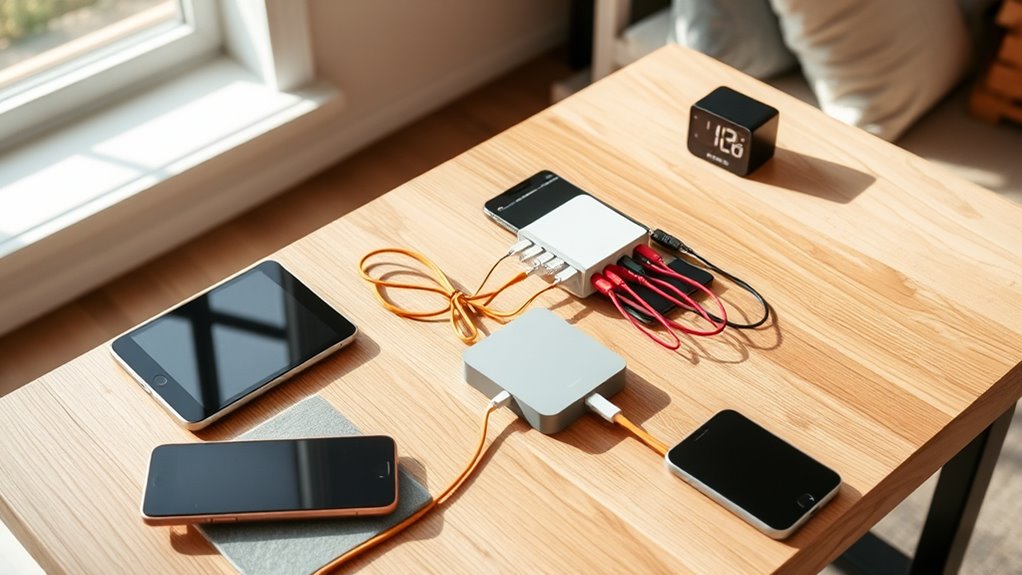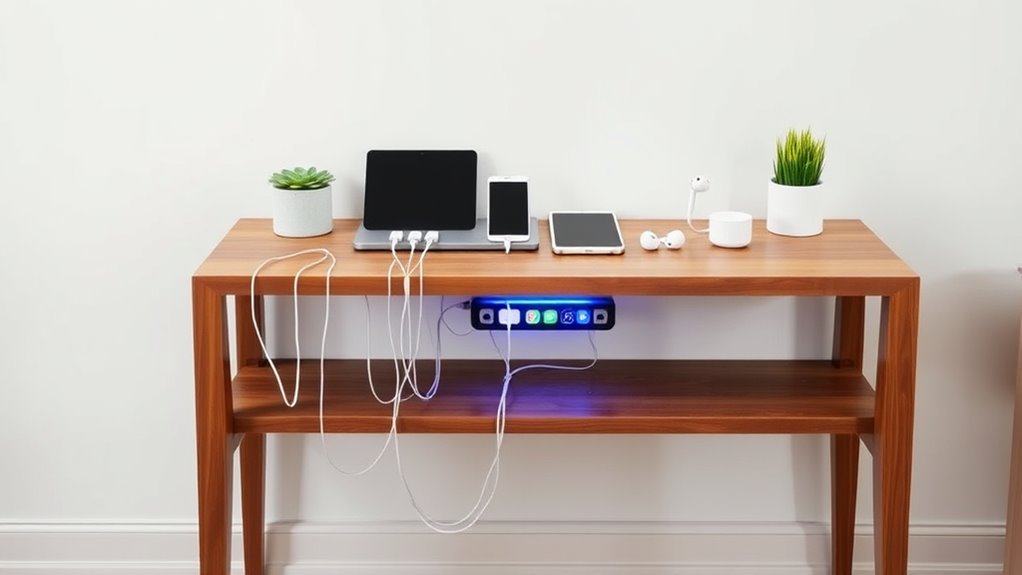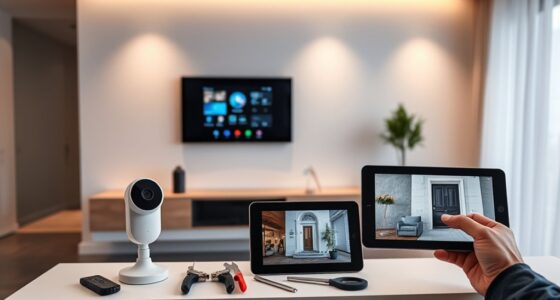To set up a family charging station, choose a convenient, unobtrusive spot like a kitchen corner or side table. Use a high-quality power strip with enough outlets to handle all devices, and organize cables with clips or ties to prevent tangling. Incorporate compartments or vertical storage for a tidy look, and label spots for each device. Keep it clean and update regularly—continue with these tips to create an efficient, clutter-free space that keeps everyone’s devices organized and safe.
Key Takeaways
- Choose an accessible, clutter-free location like a kitchen corner or side table for easy device access.
- Select a versatile station with multiple outlets and support for various device adapters.
- Use cable management tools and organize cords to prevent tangling and maintain a tidy space.
- Incorporate compartments or vertical designs to hide devices and reduce clutter visually.
- Regularly clean, inspect cables, and personalize the station with labels and decor for ongoing efficiency.

Setting up a family charging station can transform the way your household manages devices. It helps keep everything organized, so you’re not constantly searching for misplaced chargers or tangled cords. With a dedicated spot, you’ll find it easier to manage screen time since everyone knows where to go when their devices need a boost. Plus, it keeps devices out of high traffic areas, reducing the risk of accidental damage or tripping hazards, making your home safer for everyone.
Choosing the right location is key. Pick a spot that’s accessible but not in the way—like a corner of a kitchen counter or a side table in the living room. Make sure it’s out of sight enough to maintain a tidy look but easy enough for everyone to reach. Assess how many devices your family uses daily, including smartphones, tablets, or even gaming devices, and plan your space accordingly. Consider your budget too—there are DIY options that are budget-friendly or pre-made solutions if you prefer convenience.
When planning, think about the compatibility of your station. It should accommodate various device types, like iPhones and Android phones, which might need different cables or adapters. Ensure your power supply is sufficient; a good quality power strip with multiple outlets can help manage several devices at once. This prevents the need for multiple plugs cluttering your space and keeps everything within reach.
You have plenty of DIY options for creating your station. A pegboard setup offers a customizable and space-saving solution, while a desktop organizer provides a simple, compact option. If you want to keep devices hidden, consider a station with compartments or a vertical design to maximize small spaces. Recycled materials can make your project sustainable and budget-conscious. Whatever option you choose, include high-quality cables and adapters for reliable charging. Managing cables with clips or ties prevents tangles, and choosing durable materials ensures your station withstands daily use. Adequate ventilation is also important to prevent overheating during extended charging periods. Additionally, understanding home technology can help you select the most compatible and efficient charging solutions for your household.
Personalize your station with labels to identify device spots or add decorative elements to match your home decor. Incorporate extra storage for accessories like headphones or earbuds, and consider smart features such as wireless charging pads or USB outlets for convenience. Design it with future expansion in mind so you can easily add more devices later.
Maintaining your station keeps it functional and tidy. Regularly clean dust from surfaces and organize cables to prevent clutter. Update cables periodically to stay compatible with new devices, and inspect for any damage or wear. Educate everyone in your household on proper use and maintenance to keep the station running smoothly. Ultimately, a well-planned family charging station streamlines device management, promotes safety, and encourages a clutter-free home environment.
Frequently Asked Questions
How Many Devices Can a Family Charging Station Typically Support?
You’re wondering how many devices a family charging station can support. Typically, they handle 6 to 10 devices at once, depending on the design and number of ports. Many stations feature 6 USB ports, making it easy to charge smartphones and tablets simultaneously. Some include wireless charging pads for added convenience. With the right setup, you can keep everyone’s devices powered up and organized without clutter.
What Safety Precautions Should I Consider?
When considering safety precautions, you should always hire a qualified electrician for installation, ensuring proper wiring and dedicated circuits. Use certified chargers, avoid extension cords, and install GFCIs to prevent shocks and fires. Keep charging stations dry, protected from water, and in sheltered locations. Regularly inspect cables for damage, store equipment safely away from children, and educate your family on safe usage and potential hazards to prevent accidents.
Can I Include Wireless Charging Options?
Imagine a clutter-free haven where your devices effortlessly charge, and convenience feels like a gentle breeze. Yes, you can include wireless charging options in your setup. You just need to choose Qi-compatible pads or integrated stations, place them thoughtfully, and guarantee compatibility. This way, you simplify your charging routine, reduce cable clutter, and enjoy a sleek, modern space that’s both functional and aesthetically pleasing.
How Do I Organize Cables to Reduce Clutter?
To organize cables and reduce clutter, you should start by grouping related cables together with cable ties or clips. Use cable racks or raceways to hide cables neatly along walls or furniture. Label each cable for easy identification, and regularly check for damaged or unnecessary cords to remove. Keeping cables off the floor and in designated storage helps prevent tripping hazards and creates a cleaner, more efficient space.
Is It Cost-Effective to Set up a Charging Station?
You wonder if setting up a charging station is cost-effective. It can be, especially if you consider the long-term savings from reducing individual chargers and preventing device damage. While the initial investment varies based on hardware and space, energy-efficient options and smart technology can lower ongoing costs. Plus, a centralized station improves organization, reduces clutter, and may boost your home’s resale value, making it a smart, economical choice.
Conclusion
Now that you’ve set up your family charging station, you’ve turned chaos into calm, turning clutter into clarity. Think of it as the heart of your tech universe, keeping all devices powered and ready to go. With everything in its place, you’ll wonder how you ever managed without this organized oasis. So, embrace this new hub—because, after all, a well-charged family is a happy family. Your home just got a whole lot smarter!









